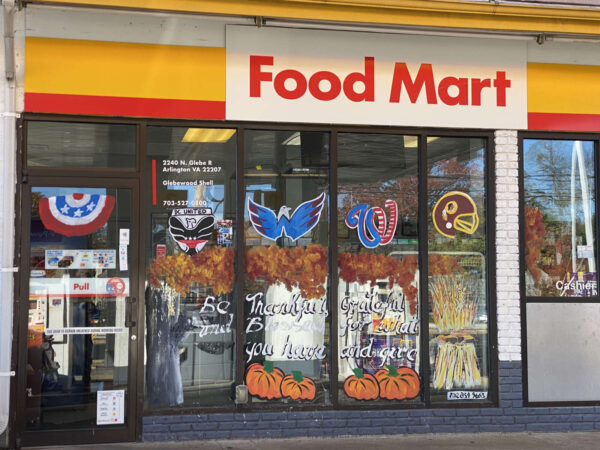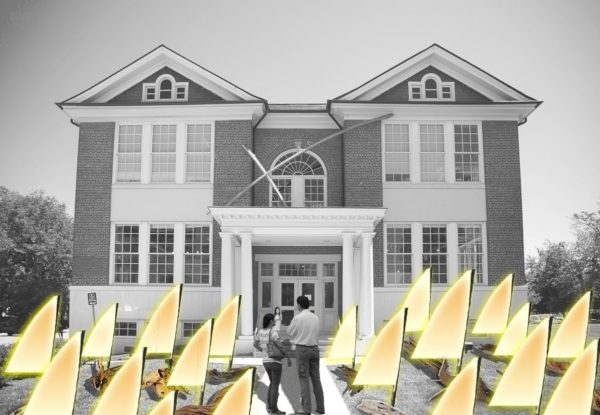It might now be an empty grassy space off of Columbia Pike, but in a few months this site will be home to a giant white spike that serves as a gateway to Arlington County.
Construction is set to begin at the southwest corner of Columbia Pike and S. Jefferson Street on The Pike, a large-scale piece of public art first commissioned nearly a decade ago. The sculpture is expected to be completed by the spring.
Foundation work is first up, beginning with surveying and site utility checks, Jim Byers of Arlington Cultural Affairs tells ARLnow.
Construction starts this week on foundation for @ARL_arts public art sculpture at Columbia Pike and S Jefferson. Most work will be 9am-4pm weekdays. Expect intermittent lane sidewalk closures. "The Pike" will be installed by spring. https://t.co/eNz0cKsC8Z pic.twitter.com/nsRqfagRhN
— Arlington Department of Environmental Services (@ArlingtonDES) November 15, 2021
To facilitate the work, there will be intermittent lane and sidewalk closures on both Columbia Pike and S. Jefferson Street. Construction will “generally” be between 9 a.m. to 4 p.m. Monday through Friday.
“Weather permitting, construction of the foundation is anticipated to be complete in December,” writes Byers.
After the completion of the foundation and a month-long concrete curing process, the sculpture itself will be installed. That’s expected to happen in early 2022.
The Pike will become part of the Arlington Public Arts’ permanent collection.
The sculpture is being made from a “reclaimed 50-foot tall wind turbine wing” and is supposed to represent a toll gate, in homage to when Columbia Pike was a toll road. The artwork’s location near the border of Arlington and Fairfax counties serves as a representative “gateway,” the county says.
The base of the sculpture will be studded with nearly 5,000 coins from all over the world, collected from county residents. The coins are another nod to Columbia Pike’s history as a toll road.
The Pike will also have lights around its base to illuminate it at night.
The sculpture was designed by Donald Lipski, who in 2017 explained he was inspired by wind turbines, toll gates, and the pike as a spear-like weapon.
“It’s just put up as this big beautiful thing. It’s a found object, it’s recycled, it’s emblematic of wind energy, it’s emblematic of a Pike, but one that’s vertical, one that’s in the open position and says, ‘Come on in. Everybody is welcome. You don’t have to pay a toll even though it used to be a Pike’,” Lipski said at a talk at the Columbia Pike Library at the time.
Back then, there were some objections to the process and design. The Arlington Mill Civic Association criticized the lack of public input and the Douglas Park Civic Association president noted that a blade and a toll gate were not great community representations.
Columbia Pike resident and ARLnow opinion columnist Chris Slatt, meanwhile, opined on Twitter that The Pike follows what appears to be the county’s preference for spikey, vertical sculptures which “would hurt King Kong if he stepped on it.”
See also: pic.twitter.com/7BItiHaq2F
— Chris Slatt (@alongthepike) November 15, 2021
The sculpture construction and installation has been included as part of the Columbia Pike Multimodal Improvement Project, a multi-year series of street improvements and utility upgrades along the entire stretch of roadway from the Fairfax border to just before the Pentagon.
The design, fabrication, and installation of The Pike is expected to cost about $250,000, writes Byers, “which is less than 1% of the total construction budget of $37 million for this portion of the Columbia Pike Multimodal Improvement Project.”
When the sculpture is completed next year, an celebration will be planned in coordination with the Columbia Pike Partnership.
Fundraiser for Man Killed in Crash — An online fundraiser for Stevan Zikic, the 26-year-old Alexandria man killed when he collided with a school bus while riding a motorcycle in Arlington’s Green Valley neighborhood, has raised nearly $35,000 for “overseas transportation and funeral costs.” [GoFundMe]
County Board Approved Pike Plan — “The County Board voted 5 to 0 to approve zoning updates that will help realize the vision of Columbia Pike as a walkable ‘Main Street’ by providing greater flexibility for commercial, office, light industrial, and agricultural uses–including animal boarding and craft beverage production — on ground floors along the Pike.” [Arlington County]
Public Art Plan OKed — “The Arlington County Board voted 5 to 0 today” — despite some last-minute opposition — “to approve an update to the Public Art Master Plan (PAMP) that will better serve placemaking efforts and improve the quality of public spaces around the County. The update, which is part of the County’s overall Comprehensive Plan, details the vision and guiding principles of public art in Arlington and sets priorities and themes centered around goals to integrate, expand, connect and engage through public art installations around the County.” [Arlington County]
Unhoused Taking Up Residence Under Bridge — “Eight months after the W&OD bicycle-pedestrian bridge opened at the Arlington-Falls Church border, members of our homeless population have gravitated there… I’m told by Kurt Larrick, assistant director of the Human Services Department. ‘Our outreach teams,’ which include PathForward volunteers, ‘are making regular visits.’ On Oct. 15, they spoke to two men sleeping at the base of a footing for the bridge. They didn’t seem interested in services now but agreed to discuss the possibility when reminded of the location’s vulnerabilities.” [Falls Church News-Press]
Beyer ‘Falling Short’ in Fundraising — “Let’s say you’re independently wealthy, well-regarded by most constituents (even from the opposition party) and occupy a district so reliably Democratic that the only way an incumbent could possibly lose the seat is via a scandal… What would you be doing? If you were U.S. Rep. Don Beyer (D-8th), you’d still be asking supporters to send you money.” [Sun Gazette]
Two Men Beaten in Crystal City Area — “Victim One was inside the business in line at the register behind the suspect, when the suspect allegedly turned around, struck him in the face, exited the business and verbally threatened him from outside. A short while later, Victim Two attempted to enter the business when the suspect, who was still standing outside, allegedly struck the victim in the back of the head with a blunt object before fleeing the scene on foot. Arriving officers located Victim Two outside of the business with a large laceration on the back of his head and administered aid until medics arrived on scene.” [ACPD]
Here Comes the Flu — From Virginia Hospital Center ER chief Mike Silverman’s latest social media post: “Our COVID isolation numbers in the ED have been pretty stable over the last 3 weeks. We’re better than a month ago but we continue to have a steady number of patients who require our COVID isolation protocol. Hospital wide, our inpatient census is up a touch from last week and our overall percent positive rate for the hospital is also up a bit. We are starting to see just a sprinkling of flu cases over the last month. It’s not too late to get your flu shot.” [Facebook]
It’s Monday — Today will be breezy and mostly sunny, with a high near 51. West wind 9 to 16 mph, with gusts as high as 32 mph. Sunrise at 6:51 a.m. and sunset at 4:54 p.m. Tomorrow will be mostly sunny, with a high near 53.
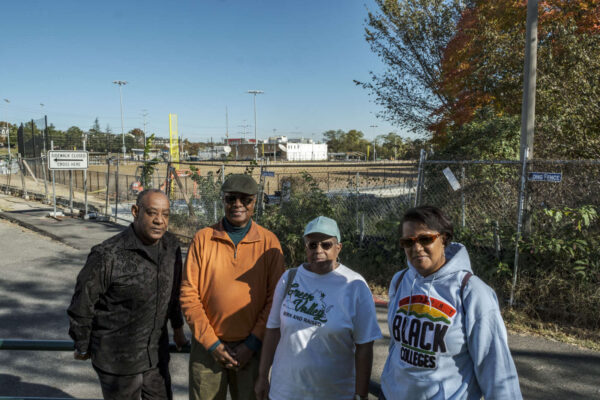
(Updated at 4:10 p.m.) A public art plan slated for consideration this weekend has angered some Green Valley residents, who say it essentially erases a portion of the historically Black community.
After multiple years of community engagement and study, county arts staff have drafted an update to the Arlington’s Public Art Master Plan (PAMP) — first adopted in 2004 — to reflect changing county values, such as equity and sustainability, and more modern public art practices. The updated strategy for bringing art into public spaces is slated for a County Board vote this Saturday.
“Public art will continue to be a timely and timeless resource, responding to current community priorities while creating a legacy of artworks and places that are socially inclusive and aesthetically diverse features of Arlington’s public realm,” the county wrote in a report about the updated plan.
But members of the Green Valley Civic Association are urging County Board members not to approve the updated plan without wording changes to the various references to their community.
“This master plan aims to nullify a historically Black community in Arlington,” they said in a letter to the County Board dated Nov. 1. “It is a painful and blatant attempt to suppress the Green Valley community and rewrite our historical narrative.”
Settled by free African-Americans in 1844, Green Valley — formerly known as Nauck — is one of Arlington’s oldest Black communities. Its borders are S. Arlington Mill Drive to the south, the Douglas Park neighborhood (and S. Walter Reed Drive) to the west, I-395 and Army-Navy Country Club to the east, and the Columbia Heights neighborhood to the north.
Geography and names comprise two chief concerns for residents, who take issue with the document’s use of the monicker “Four Mile Run Valley” to refer to an area north of Four Mile Run near Shirlington — much of which is actually part of the historic Black community.
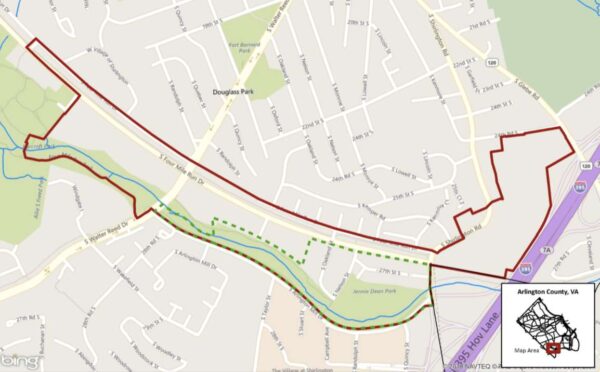
The name “Four Mile Run Valley” started being used widely by the county in connection with a planning study that discussed the proposed creation of an “arts and industry district” in the area. But Green Valley residents are taking exception to the term being used instead of their neighborhood’s actual name.
“This is wholly incorrect and offensive,” the civic association said.
More from the letter:
The report defines a fictitious community of “Four Mile Run Valley.” This heretofore non-existent community is defined as running from the “north bank of the stream where the lower and upper reaches meet.”
It further, incorrectly states, that Shirlington Village is “on the south bank of Four Mile Run.” It is not. The northern border of Shirlington Village begins in the middle of Arlington Mill Drive.
The report states, “Green Valley is a historically African-American neighborhood to the north of Four Mile Run Valley.” This is wholly incorrect and offensive. Again, “Four Mile Run Valley” is a fictitious name created by county staff. It is not a location. The southern border to Green Valley begins in the middle of Arlington Mill Drive. To try to push the historic boundary of our community up the hill is unconscionable and disrespectful of what Green Valley means to Arlington.
Civic association president Portia Clark says this turn of phrase is part of a pattern of erasure.
“This isn’t the first time the county has tried to paper over Green Valley. Green Valley established in 1844 was rebranded Nauck in 1874, after a confederate soldier purchased land in our freed Black community,” Clark said. “We finally got our name back in 2019, only to find the county trying to discard us again. This time the county tried to hide the deed in the middle of a 200-page arts report.”
Just after publication of this article, county staff told ARLnow that some of the changes suggested by the civic association have been made.
The cement spheres of “Dark Star Park” in Rosslyn, the electric blue ribbon of “Dressed Up and Pinned” in Courthouse and the twin striped monoliths of “Echo” in the park at Penrose Square.
These are some of the roughly 70 permanent public art projects in Arlington, commissioned for county capital improvement projects, sponsored by developers or initiated by communities.
Made with cement, steel and stone, these permanent projects are built to last, such as “Dark Star Park,” installed in 1984. The focus on permanent art installations — in particular those integrated into large capital projects — is intentional, according to Arlington’s Public Art program, a subdivision of Arlington Economic Development’s Cultural Affairs division.
“For as long as you have me leading the program for Arlington County, you’re going to have someone fighting for the very difficult work of integrating public art into larger county capital projects,” Public Art Administrator Angela Adams said in a recent Planning Commission meeting. “It’s not the easy thing to do. Temporary public art is the easy thing to do. Murals are the easy thing to do. We don’t do murals: we assist the community to do their own murals.”
The county considers murals, which can last a few decades if maintained well, temporary public art. Most recently, the program provided assistance for the creation of the John M. Langston mural at Sport Fair by KaliQ Crosby.
The county’s emphasis on sculptures over murals and other temporary works received some pushback from Planning Commission members during a discussion about the county’s Public Art Master Plan, which is being updated to reflect modern times.
After multiple years of community engagement and study, arts staff drafted an update to the plan — first adopted in 2004 — that reached the County Board last Saturday. Members approved a request to advertise a public hearing on the updated document next month, ahead of a vote on whether to adopt it.
“It’s a strategy for how public art will improve the quality of our public spaces,” Board Chair Matt de Ferranti said during the meeting. “We each got briefed on this. I think it’s important.”
The Public Art program’s current emphasis on sculptures and other installations, like the lighted bridge over Route 50 near Courthouse and Corridor of Light in Rosslyn, prioritizes the permanent over the ephemeral, quality over quantity. But it also comes at a cost, often requiring significant funding and years of planning. Plus the artists with the reputation and know-how to create such art in many cases come from out of town.
By contrast, the public art one more commonly sees posted on social media these days are of the more temporary variety: Instagrammable murals and community-created installations. Cheaper and impermanent, such art has the possibility of being more ubiquitous around town and more reflective of the current moment and the local flavor. Such is the case with a mural unveiled over the summer in the Town of Vienna, a set of painted, social-media-ready butterfly wings designed by a graduate of a local high school.
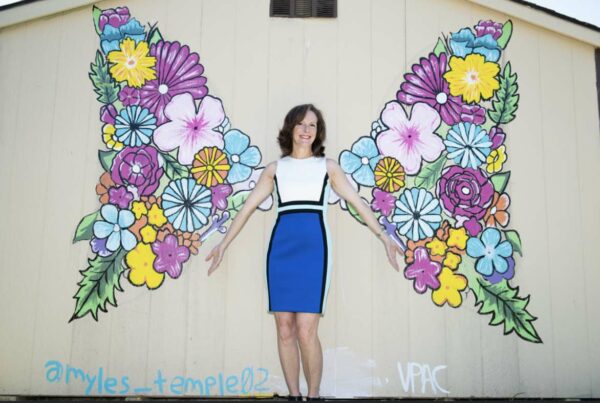
Public art by the numbers
Since the 1970s, Arlington County and private developers have completed more than 100 permanent and temporary works of public art. But it wasn’t until 2004 that a systematic approach, called the Public Art Master Plan (PAMP), was codified.
More than 25 permanent projects have been completed or are in progress, while more than 30 temporary works have been commissioned or supported since the PAMP was adopted, the updated plan says. These are funded by county capital improvement funds and developer contributions to the Public Art Fund.
Developers have completed and commissioned more than 25 works to adorn their sites, Public Art program spokesman Jim Byers, Jr. said. Most developers (65%) contribute to the Public Art Fund, which has received 59 contributions since 2004 and today maintains a balance of $3 million, he said.
Their coffers go a long way, Byers said, as “developer and partner funding leverages the county Public Art funding by nearly 25:1.”
Out with the old, in with the new
Despite its successes, the PAMP update says the county’s public art approach needed a fresh coat of paint “to support the County’s civic engagement, planning, economic development and placemaking.”
Among other new priorities, the new plan emphasizes audience development and engagement and equity, and identifies two new priority corridors: Langston Blvd and the Potomac Riverfront. The existing priority corridors are Rosslyn-Ballston, Richmond Highway, Columbia Pike and Four Mile Run.
Audience engagement is a priority because residents seem to know little about the program, the plan admits. It calls for more programming to engage folks and more accessible information about projects.
“One of the things the research showed is that the Arlington community is not fully aware of the breadth of the County’s public art resources,” the PAMP continues. “It is important not only to commission new works, but also to find ways to keep existing artworks fresh in people’s minds.”
(Updated 9:20 a.m.) A Dominion Energy substation under renovation near Crystal City is set to electrify the neighborhood with an artistic façade.
The energy provider is expanding and remodeling its substation at the intersection of S. Hayes Street and S. Fern Street to meet the increasing demand for electricity as the population in the National Landing area — and Amazon’s nearby HQ2 — grows. It obtained the extra land needed for the expansion a year ago through an agreement with the County Board.
As part of the renovation, Dominion will be adding public art to one building face — “inVisible” by California-based artist Elena Manferdini — and building a public plaza.
Manferdini’s energetic design features vibrant ceramic tiles interacting with grayscale panels that extend toward the sky. But it’s a big departure from the “cloud concept” Dominion chose last year in response to community feedback.
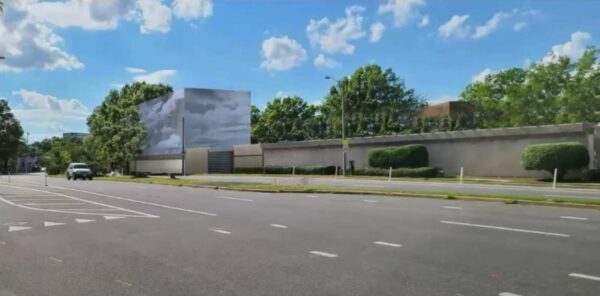
Her livelier proposal proved polarizing. While well-received by Dominion — and approved by the Arlington County Public Art Committee in March — reactions during last month’s Arlington Ridge Civic Association meeting were negatively charged for two reasons, says one attendee.
“1) Although the good intention to keep the building from being bland was well understood by the attendees, the artwork seemed too ‘busy’ for them, and 2) the artwork is being done by a non-local artist,” Tina Ghiladi said in an email. “At best, some reactions were neutral, because the substation is not in Arlington Ridge nor within our line of sight.”
Dominion Energy spokeswoman Peggy Fox says Manferdini, an award-winning artist with two decades of experience, was chosen on the strength of her proposal.
“We were hopeful to find a local artist for this project,” Fox said. “However, Elena proved to be the superior candidate by listening to both the desires of the community and representing the function of a substation and its ‘invisible’ importance in the community. It was clear she did her homework and drew inspiration from both angles. Elena (and her design ‘inVisible’) was chosen because she was the best candidate for this job.”
Manferdini describes her project as a representation of the unseen force of electricity and an invitation to the audience to question their relationship to it.
“Every day, we are surrounded by one of the most important innovations of all time, electricity,” she said in a March meeting. “Its energy powers every area of our modern lives. And yet we can’t see it. Like gravity, electricity is an invisible force we only recognize when it acts upon other objects.”
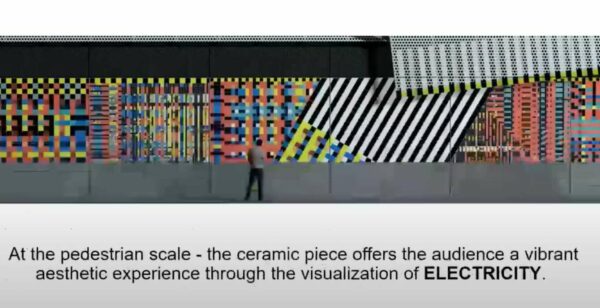
Ghiladi says some negative reaction softened when Dominion explained her vision and that she was selected “because of her experience in, and passion for, the subject.” Overall, neighbors like the other changes, she says.
“The members were positive/supportive about all other aspects of the project, namely improving our power network, as well as the removal of the lattice roof,” she said.
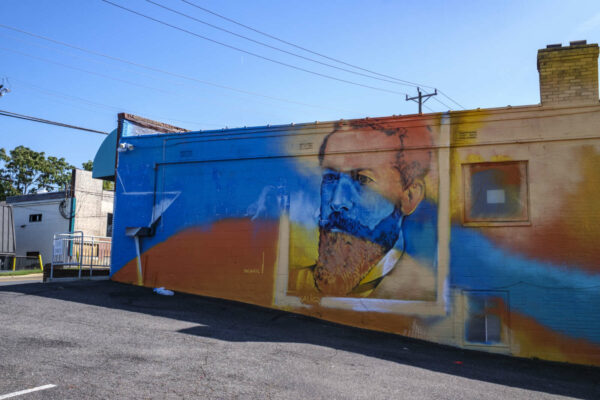
The recently-renamed Langston Blvd is getting a larger-than-life mural of its namesake, Black abolitionist John M. Langston.
The public artwork commemorates the struggle for racial equality in Arlington and the renaming of Route 29, previously named for Confederate Gen. Robert E. Lee.
Work on the outdoor public art is set to finish within the next week and a half, Langston Boulevard Alliance executive director Ginger Brown said. The mural adorns a wall on the side of swimming store Sport Fair (5010 Langston Blvd), which was chosen for its location in the historically Black neighborhood of Hall’s Hill, as well as its visibility from the road.
The new name and mural pay tribute to Langston, who was Virginia’s first Black congressional representative and served as the first dean of Howard University’s law school and the first president of Virginia State University.
It will also incorporate the places and moments in Arlington’s history of racism and racial progress. The Langston Boulevard Alliance says it worked with the artist, D.C. native Kaliq Crosby, to include depictions of Arlington’s Freedman’s Village, established after the Civil War, the segregation of the Hall’s Hill neighborhood and the integration of public schools.
“There is a significant piece of the mural that… came [about] during the design process,” Brown said. “The historic John M. Langston School will be included in the mural. It is the school where all of the Hall’s Hill children went before the Stratford School was integrated.”
About a block from the mural, the elementary school for Black children operated until Arlington County closed it in 1966 as part of its desegregation plan. Today it is the Langston-Brown Community Center (2121 N. Culpeper Street), which also houses alternative high school programming.
A ribbon cutting for the mural, which was co-sponsored by Arlington Arts and Arlington Economic Development, is slated for later this week. Crosby has completed other racial justice and civil rights-themed murals in the D.C. area, including a recent mural of inaugural poet Amanda Gorman in Dupont Circle.
The Langston Boulevard Alliance will celebrate the renaming of the corridor next month with a pair of public events on Saturday, Oct. 2: a walking tour of Langston Blvd’s racial history and a fall festival at Woodstock Park featuring food, music and family-friendly activities.
There will also be an art gallery featuring the works of local Black artists at Dominion Lighting (5053 Langston Blvd) from Oct. 2-31.
American Legion Post 85 in Virginia Square is getting a new mural.
The post at 919 N. Kansas Street — not to be confused with the nearby, under-construction Post 139 two blocks away — commissioned the work from Falls Church artist Mary Tjeng, who was busy painting when ARLnow stopped by Thursday afternoon.
The mural depicts Gen. Billy Mitchell, the post’s namesake and the “father of the U.S. Air Force.”
Mitchell “is one of the most famous and most controversial figures in the history of American airpower,” says an old website for the Legion post. “So great was his impact on the Army Air Service and its successor organizations that the effect is still being felt. During Mitchell’s meteoric military career, he charted new paths, set new standards, and influenced key leaders for decades to come.”
“Mitchell was twenty years ahead of his time when he put forth his detailed vision of a hazardous future,” the website says of the general, who served in World War I and died in 1936 after retiring to a farm in Middleburg. “He is also the only individual after whom a type of American military aircraft, the B-25 Mitchell, is named.”
The mural, which recently received some attention from National Defense magazine’s Twitter account, will adorn an exterior wall that’s partially visible from Wilson Blvd.
A muralist painting tribute to “father of the Air Force” Gen. Billy Mitchell. American Legion Post No.85 in Arlington, VA pic.twitter.com/5aLcqAxw5S
— National Defense (@NationalDefense) July 15, 2021
Jay Westcott contributed to this report
As Cowboy Cafe (4792 Lee Highway) adds new outdoor seating, as temporarily allowed by the county, co-owner Jim Barnes wanted to spruce out the exterior of the restaurant a little.
The result: a towering, colorful mural currently being painted onto an empty brick wall.
Local artist MasPaz — whose distinctive style can be found from across the region from D.C. to Tysons — has been working on designing and painting the mural. The artwork’s design was inspired by the Wynwood Walls in Miami, but the theme came from the local response to COVID-19.
The project spun out of the Arlington Art Truck program when participants were asked to summarize their feelings on life in Arlington under the quarantine, according to the Lee Highway Alliance. MasPaz’s word was “community” and the subsequent mural depicts someone hugging several homes close to them.
Beyond the mural, the new patio will also feature lighting and other renovations. The plan is to host a ribbon-cutting ceremony, but the Lee Highway Alliance is still awaiting the final lighting installation, later this month.
A new public art project set to debut later this summer will place numerous model slave ships in front of the Arlington Arts Center (3550 Wilson Blvd) in Virginia Square.
Local artist Lynda Andrews-Barry‘s display of 25 wooden slave ships, formed from driftwood collected from the Chesapeake Bay, will fill the lawn in front of the arts center. The ships will be staked into the ground and have sails that collect sunlight during the day and light up at night.
According to Barry:
This site-specific project was conceived through researching Arlington Arts Center and its location in the former Maury school. The institution’s namesake, Matthew Fontaine Maury, was a native Virginian astronomer, historian, oceanographer, meteorologist, cartographer, author, geologist, education, United States Navy officer, and Chief of Sea Coast, River and Harbor Defenses for the Confederacy. However, Maury was not a proponent of American slavery. Instead he favored relocating slaves (and their owners, if desired) to the Amazon, and sent a crew there to map the river and determine if his plan was feasible.
Maury’s proposal was part of a broader movement to relocate, rather than integrate, Black Americans formerly held as slaves. A school in Alexandria is also named after Maury.
The artwork commemorates the 12 million people captured and loaded onto those ships as cargo, some of whom Barry said she is descended from.
Megan Niewold, director of development at the Community Foundation for Northern Virginia, said the project was funded by a $10,000 grant. Niewold said the focus of the grant this year was on funding public art that was helping to transform communities.
“We wanted to do public art opportunities that were accessible for everyone and in a diverse area,” Niewold said. “[The project] had to be public, interactive, environmentally friendly, and had to talk about a big topic and encourage heavy discussion.”
Niewold said ten submissions were considered in the final review, but a volunteer grants committee was particularly impressed with how this design tackled race relations and the history of the Maury school — as well as the use of reclaimed driftwood.
The project was originally supposed to go up in April, Niewold said, but the foundation didn’t want to promote more public art during the height of COVID-19 so the timeline was changed to mid-August.
Image via The Community Foundation for Northern Virginia
(Updated at 1:50 p.m.) A long-planned public art installation is finally becoming a reality in Rosslyn.
The first four stainless steel pylons of the “Corridor of Light” project are being installed along N. Lynn Street in Rosslyn, on either end of the bridge over I-66. Installation of the pylons started this past Monday; the installation of lighting and electrical connections is expected to be complete by Monday, May 25.
The project from California-based artist Cliff Garten was first envisioned in 2008, in the midst of the financial crisis. Now, during what may be a deeper, pandemic-fueled recession, the first of Garten’s “Luminous Bodies” sculptures are now in place and will soon be lighted.
“The four 26′ tall stainless steel sculptures are a major milestone for the ‘Corridor of Light,’ a three-phase, 13-year effort to create a new urban identity for Rosslyn’s central corridor,” Arlington Arts said in a Facebook post that was accompanied by a video of the installation, below.
We’re told by a tipster that the sculptures will be initially lighted blue, “to honor our health care professionals.”
Arlington Cultural Affairs spokesman Jim Byers said passersby can expect “splashes of light fractured into a multitude of effects.”
“Ultimately, the sculptures of stainless steel rods will be enhanced with an LED lighting scheme designed and programmed by the artist,” Byers said. “Prior to the artist programming the lights, the initial lighting plan will serve as a beacon for all Arlingtonians to reflect on our community’s response to the COVID-19 pandemic.”
Byers was unable, however, to confirm that the initial lighting scheme will be blue in honor of health care workers.
“Arlington Public Art staff are still in consultation with the artist about the specifics of the initial lighting to be unveiled on May 25,” he said.
The project, which has had to wait for construction of the Lynn Street Esplanade project, has been beset by delays. In 2014, ARLnow reported that the first pylons were expected to be installed in 2017. The County Board approved a $1 million contract with Garten for the first four sculptures in 2016. The county reported that the Esplanade project was “substantially complete” as of last month.
The first phase of the Corridor of Light project was a Garten-designed LED light display near the Rosslyn Metro station, dubbed “Gravity and Grace,” which the county says was installed in 2018.
A third phase would see the installation of additional lighted Luminous Bodies pylons on the N. Meade Street bridge over Route 50. So far, there’s no word as to when that might take place.
Over the next two-weeks, LUMINOUS BODIES by Cliff Garten will be installed at the Lynn Street Esplanade (North Lynn Street and Lee Highway, above Route 66 at the approach to Key Bridge). The four 26’ tall stainless steel sculptures are a major milestone for the “Corridor of Light,” a three-phase, 13-year effort to create a new urban identity for Rosslyn’s central corridor. When completed, the sculptures of stainless steel rods will be enhanced with LED lights programmed by the Artist. On the underside of the dome of each structure, passerby will see splashes of light fractured into a multitude of effects by the steel rods. Look for this iconic new gateway into Arlington when installation, lighting and adjustments will be completed by Mon., May 25.
Posted by Arlington Arts on Monday, May 11, 2020
The Crystal City Business Improvement District (BID) is working to enliven some of the local storefronts during the pandemic.
A new art initiative called #LoveNationalLanding is adding a little color to some of the local businesses across Pentagon City, Crystal City and Potomac Yard, an area that was collectively branded as “National Landing” when Amazon announced its move into the area. The Crystal City BID was also recently approved for a name change and boundary expansion to encompass the entire area.
“The initiative kicked off with the unveiling of an array of vibrant artwork featuring sunbursts, blooming flowers, and oversized hearts emboldened with encouraging messages across several storefronts in National Landing,” the BID said in a press release. “Drawing inspiration from Andy Shallal’s #PaintTheStorefronts program, and neighborhoods across the country that have utilized art to beautify the public realm during the COVID-19 crisis, the BID worked with curator Tom Pipkin to select a lineup of local artists who were then tasked with creating facade designs that would serve as a source of community-wide inspiration.”
Chosen artists include:
- Cris Clapp Logan, a watercolor and ink illustrator
- Jeff Huntington, aka Jahru, a local muralist
- Patrick Owens, a muralist who added Mothra to a D.C. mural per the request of a local boy
- Juan Pineda, a street artist
- Erik Ricks, a muralist who worked on displays in Takoma, D.C.
- Chelsea Ritter-Soronsen, a chalk artist and arts organizer
The BID said local storefronts that are getting the artwork include Commonwealth Joe, Enjera, Freddie’s Beach Bar, Jaleo, and Los Tios, with more storefronts planned. A video, below, shows one of the murals being created at the Vintage Dress Company on 23rd Street S.
“We are thrilled to introduce our #LoveNationalLanding campaign and couldn’t think of a better way to launch this initiative than the painted storefront campaign, which conveys our unwavering support for our small businesses and the vital role that public art plays in our community,” said Tracy Sayegh Gabriel, Crystal City BID president and executive director, in the press release. “As this initiative advances over the course of the month, residents, workers and visitors can expect to encounter additional bursts of color and messages of encouragement throughout the National Landing area.”
Another muralist team, Brocoloco, has also been enlisted to create vinyl wraps for welcomes boxes and 100 street decals with messages placed around Crystal City.
Photos via Crystal City BID/Facebook


